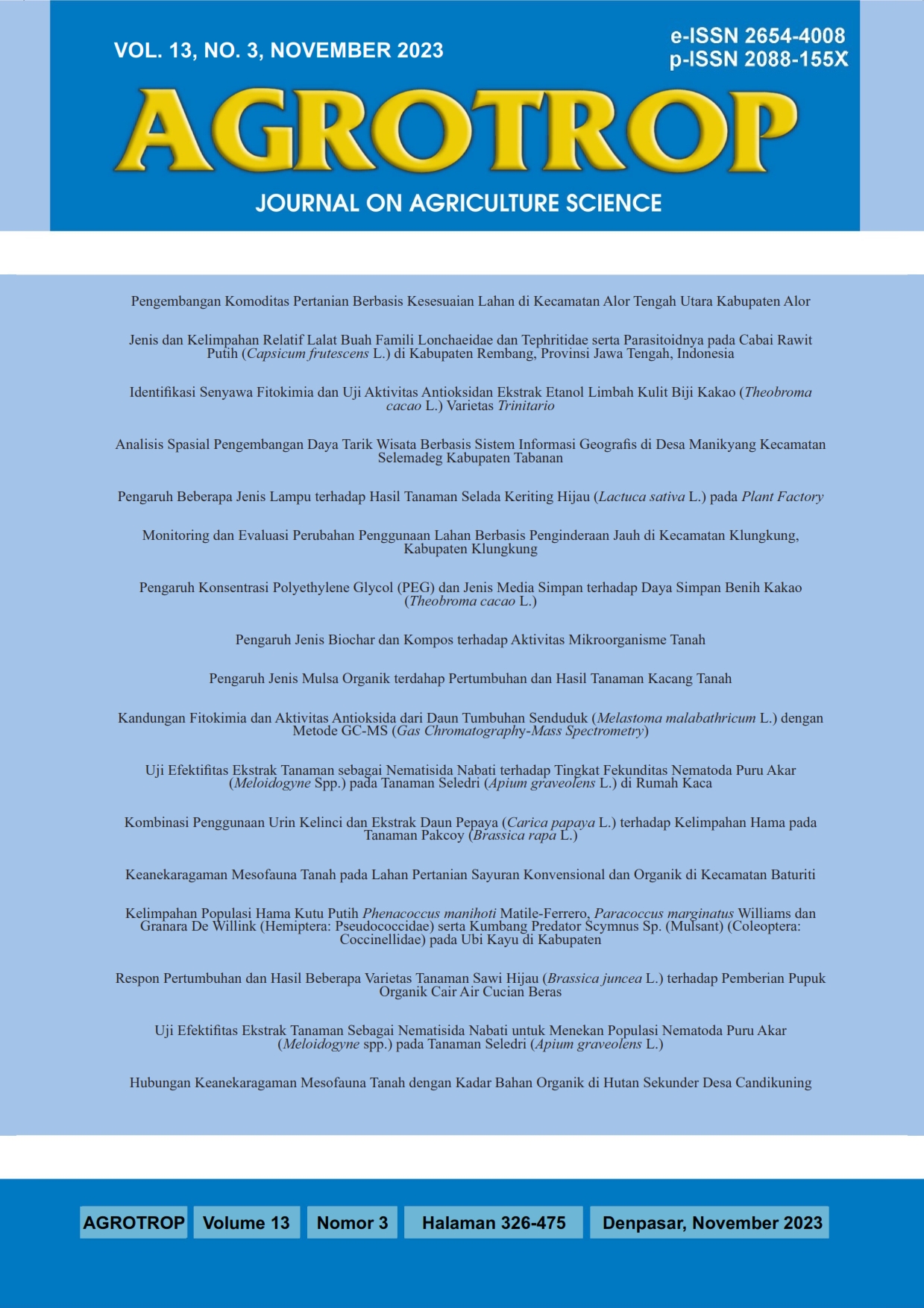Pengaruh Jenis Biochar dan Kompos terhadap Aktivitas Mikroorganisme Tanah
Abstract
The Effect of Biochar Types and Compost on Soil Microorganism Activities. This research was carried out at the plastic house of Pasraman Unud Jimbaran from January to June 2021. The type of biochar used come from waste materials such as bamboo, rice husks, coconut shells, and corn cobs, while the compost was selected according to Indonesian National Standards. The purpose of this study was to determine the biochar material from several wastes combined with compost in supporting the activity of soil microorganisms as well as the N, P, K, pH and C-organic soil. The experimental design used in this study was a Simple Completely Randomized Design with 9 treatments and 3 replications so that it became 27 experimental units. The experimental treatments consisted of: B0 (control); B1 (1.5% rice husk biochar/ha); B2(1,5% biochar bamboo/ha); B3 (1.5% corncob biochar/ha); B4 (1.5% coconut shell biochar/ha); B5 (0.75% rice husk biochar + 0.75% compost)/ha; B6 (0.75% bamboo biochar + 0.75% compost)/ha; B7 (0.75% corncob biochar + 0.75% compost)/ha; B8 (0.75% coconut shell biochar + 0.75% compost/ha). Monitoring of media humidity is carried every 2 days and stirring once a week. Observations were made at the end of the incubation period (35 days) on soil respiration, C-organic, N-total and pH. The results showed that the highest activity of microorganisms occurred in the B6 treatment (0.75% bamboo biochar + 0.75% compost)/ha. The addition of (biochar + compost) to the soil gave a significantly different effect on organic C and total soil N.
Downloads
References
Fernández, J. M., Nieto, M. A., López-de-Sá, E. G., Gascó, G., Méndez, A., & Plaza, C. (2014a). Carbon dioxide emissions from semi-arid soils amended with biochar alone or combined with mineral and organic fertilizers. Science of The Total Environment, 482–483,1–7. https://doi.org/10.1016/j.scitotenv.2014.02.103
Gani, Anischan. 2009. Potensi Arang Hayati (Biochar) Sebagai Komponen Teknologi Perbaikan Produktivitas Lahan Pertanian. Jurnal Iptek Tanaman Pangan 4 (1): 33 – 48.
Herman, W dan E. Resigia. 2018. Pemanfaatan Biochar sekam dan kompos jerami padi terhadap pertumbuhan dan produksi padi (Oryza sativa) Pada Tanah ordo Ultisol. Jurnal Ilmiah Pertanian Vol.15 (1) Agustus p.42 – 50
Magdalena, M., D. Widiastuti dan B. Lantang. 2017. Pelatihan Pembuatan Biochar dari Limbah Sekam Padi Menggunakan Metode Retort Kiln. Jurnal Ilmiah Pengabdian Kepada Masyarakat (Agrokreatif) 3 (2) : 129 – 135.
Maguire, R. O dan F. A. Agblevor. 2010. Biochar in Agricultural Systems. College of Agriculture and Life Sciences, Virginia Polytechnic Institute and State University.
Mateus, R., Kantur, D., & Moy, D. L. M. (2017). Pemanfaatan Biochar Limbah Pertanian sebagai Pembenah Tanah untuk Perbaikan Kualitas Tanah dan Hasil Jagung di Lahan Kering.
Steiner, Christop. 2007. “Soil Charcoal Amandements Maintain Soil Fertility And Establish Carbon Sink – Research and Prospects” Soil Ecology Reseach Development : 1 – 6.
Utomo, W.H, Sukartono, Z. Kusung and W.H Nugroho.2011. Soil Fertility Status, Nutrient Uptake, and Maize (Zea mays.L)Yield following Biochar and Catted Manure Aplication on Sandy Soils of Lombok, Indonesia. Journal of Tropical Agriculture 49 (1-2) ; 47 -52.
Putri, V.I, Mukhlis, B. Hidayat. 2017. Jurnal Agroekoteknologi FP USU E-ISSN No. 2337-6597 Vol.5.No.4, Oktober 2017 (107): 824-828824
Widodo, K.H., Z.Kusuma. 2018. Pengaruh Kompos Terhadap Sifat Fisik Tanah dan Pertumbuhan Tanaman Jagung di Inceptisol. Jurnal Tanah dan Sumber Daya Lahan. Vol.5. VNo.2 : 959-967. E-ISSN-2549-9793.
Pranata, M. B. Kurniasih. 2019. Pemberian Pupuk Kompos Jerami Padi terhadap Pertumbuhan dan Hasil Padi (Oryza Sativa.L) pada Kondisi Salin. Vegetalita.2019.*(2) : 95 – 107.











